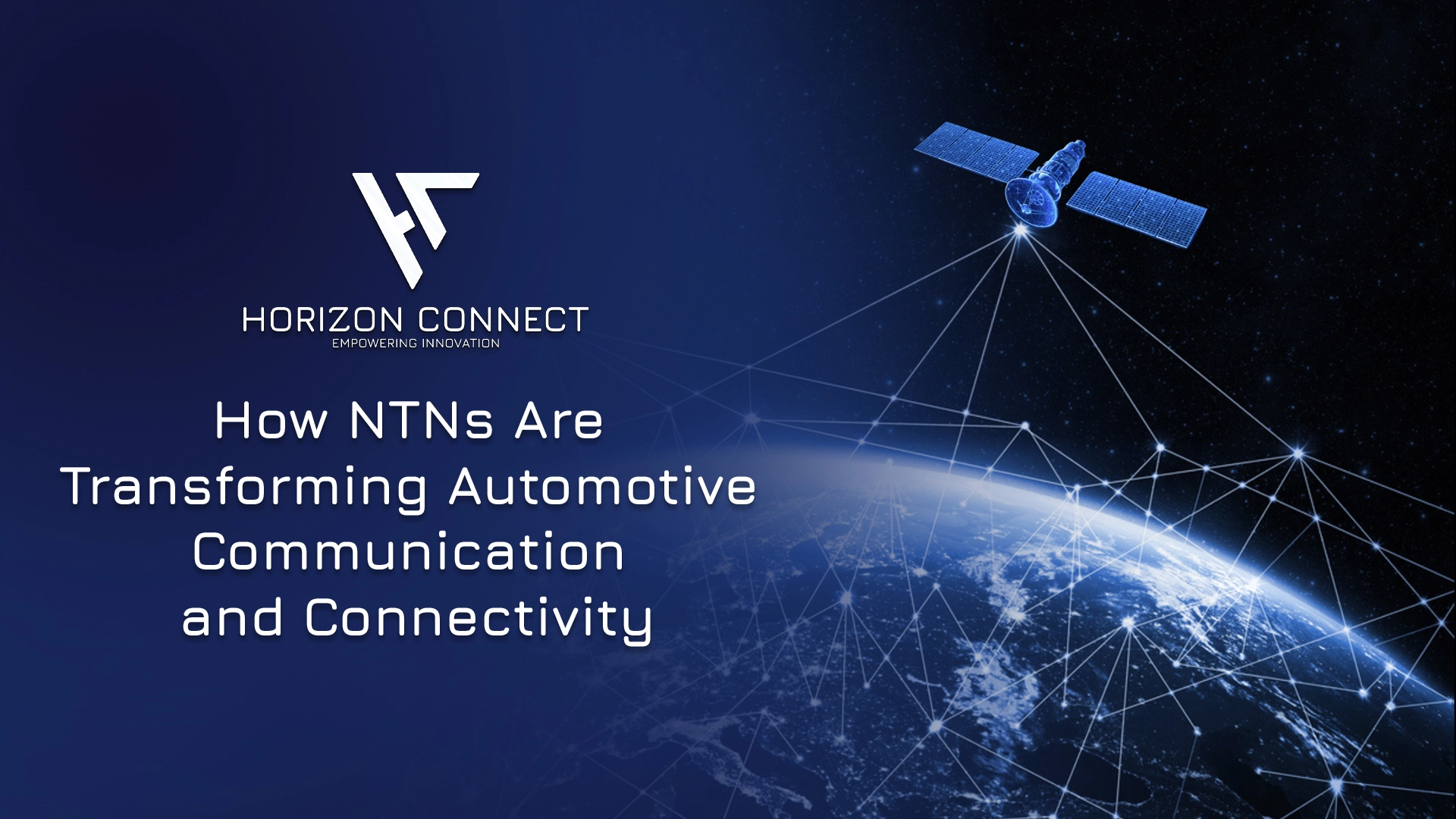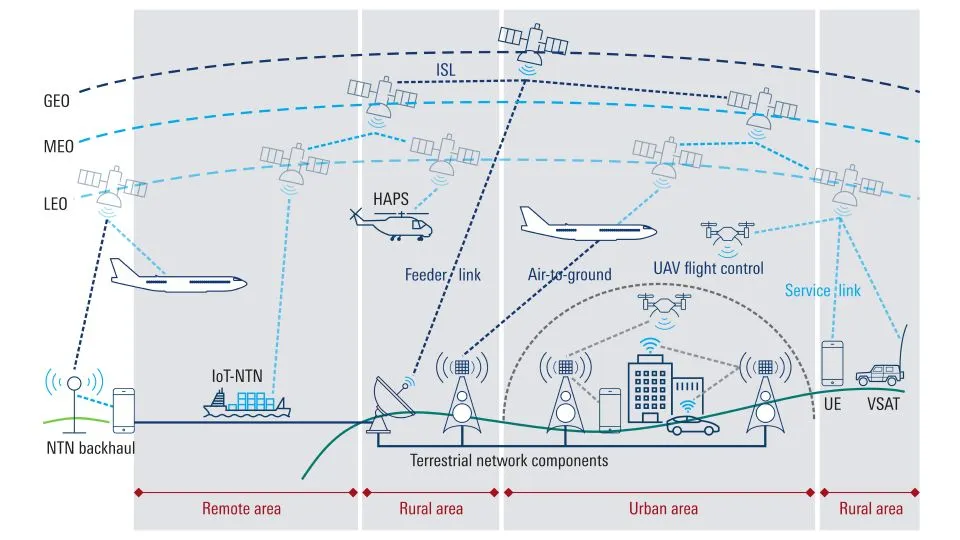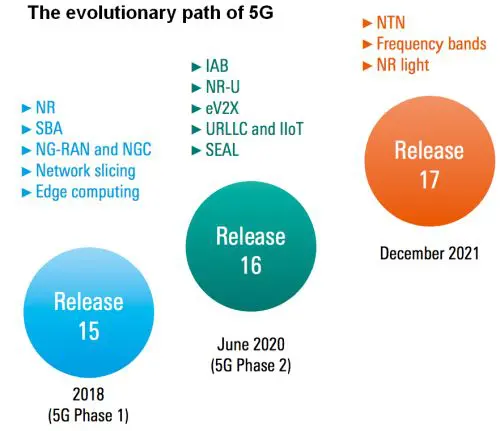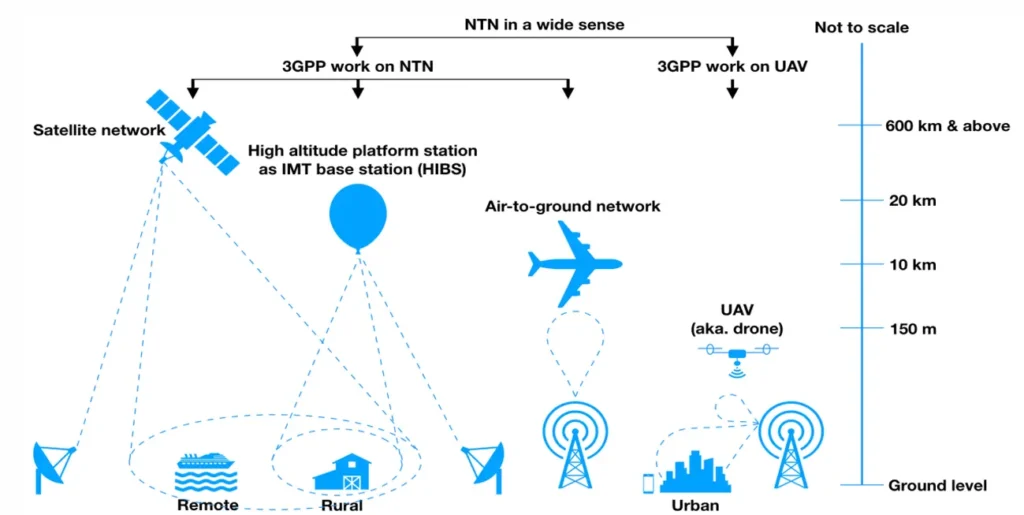The rise of NTNs in automotive is revolutionizing communication and connectivity for connected vehicles. By leveraging Non-Terrestrial Networks (NTNs) such as satellites, High-Altitude Platforms (HAPs), and Unmanned Aerial Vehicles (UAVs), the automotive industry can overcome traditional network limitations, ensuring seamless global coverage, ultra-low latency, and reliable communication. NTNs are paving the way for advanced Vehicle-to-Everything (V2X) communication, autonomous driving, and next-generation connected mobility solutions.

What Are NTNs in Automotive?
NTNs (Non-Terrestrial Networks) refer to communication systems that operate outside conventional terrestrial infrastructures. They use non-terrestrial flying objects to provide connectivity, especially in remote and challenging environments. The primary components of NTNs are:
- Satellites: Offering global coverage with Low Earth Orbit (LEO), Medium Earth Orbit (MEO), and Geosynchronous Earth Orbit (GEO) satellites.
- High-Altitude Platforms (HAPs): Operating in the stratosphere, HAPs deliver low-latency communication for real-time V2X interactions.
- Unmanned Aerial Vehicles (UAVs): Enhancing local connectivity and dynamic communication in urban and rural settings.
These components work together to provide continuous communication, supporting the needs of modern connected vehicles.

How NTNs Enhance Automotive Communication
- Seamless Global Coverage with NTNs
One of the biggest challenges for connected vehicles is maintaining reliable communication in remote or rural areas. NTNs in automotive solve this by providing uninterrupted global coverage through satellite constellations. This ensures vehicles stay connected regardless of their location, enhancing safety, navigation, and infotainment services. - Ultra-Low Latency in NTNs
High-Altitude Platforms (HAPs) and UAVs operate closer to Earth than traditional satellites, significantly reducing latency. This is crucial for autonomous driving and real-time V2X communication, where milliseconds can make a difference in decision-making and safety. - Reliable Connectivity Using NTNs
NTNs integrate multiple layers of non-terrestrial platforms, creating a resilient and robust network. This layered architecture ensures continuous communication, even in adverse weather conditions or challenging terrains, making it ideal for connected and autonomous vehicles. - NTNs for Enhanced V2X Communication
With Vehicle-to-Everything (V2X) communication becoming more sophisticated, NTNs provide the necessary bandwidth and coverage for real-time data exchange. This supports communication between vehicles, infrastructure, pedestrians, and networks, ensuring safer and smarter mobility. - Support for Advanced Applications
NTNs facilitate data-intensive applications by providing high-speed, low-latency communication links.
3GPP NTN: Pioneering Automotive Connectivity with Horizon Connect
3GPP NTN (Non-Terrestrial Networks) represents a groundbreaking step in integrating non-terrestrial platforms with 5G communication systems. The 3rd Generation Partnership Project (3GPP) began standardizing 5G technology with Release 15 in 2018, followed by its evolution in Release 16 and ongoing enhancements in Release 17. One of the key advancements is enabling 5G systems to support NTNs, which has become essential for expanding connectivity in automotive communication.

NTNs include a range of non-terrestrial flying objects that enhance global communication coverage:
- Satellite Communication Networks: Utilizing spaceborne platforms such as Low Earth Orbit (LEO), Medium Earth Orbit (MEO), and Geosynchronous Earth Orbit (GEO) satellites. These systems provide reliable connectivity even in remote areas. Leading satellite constellations like Starlink, Kuiper, and OneWeb demonstrate the power of LEO NTNs for high-speed broadband.
- High Altitude Platforms (HAPs): Airborne platforms, including airplanes, balloons, and airships, that operate in the stratosphere. In the 3GPP context, these are known as High-Altitude Platform Stations (HIBS), providing mobile service in the same frequency bands as terrestrial networks.
- Air-to-Ground Networks: Designed to provide in-flight connectivity by utilizing ground stations with up-tilted antennas, ensuring consistent communication for airborne vehicles.
At Horizon Connect, we are at the forefront of integrating 3GPP NTN standards into our automotive communication solutions. By leveraging satellites, HAPs, and air-to-ground networks, we ensure seamless, reliable, and high-speed connectivity for connected vehicles. Our commitment to 3GPP-compliant solutions empowers OEMs and automotive innovators to deliver smarter, safer, and more connected mobility experiences.
As the automotive industry continues to evolve, Horizon Connect remains dedicated to pioneering NTN-based communication systems that redefine the future of connected vehicles.

Applications of NTNs in Automotive Connectivity
NTNs in Autonomous Driving
Autonomous vehicles rely on real-time data exchange for navigation, obstacle detection, and decision-making. NTNs provide the low-latency communication required for safe and efficient autonomous driving.
Smart Traffic Management with NTNs in Automotive
NTNs enable dynamic communication between vehicles and infrastructure, optimizing traffic flow, reducing congestion, and enhancing overall road safety.
Remote Vehicle Control Using NTNs in Automotive
With global coverage and reliable connectivity, NTNs facilitate remote monitoring, diagnostics, and software updates for connected vehicles, ensuring optimal performance and safety.
Infotainment Solutions Powered by NTNs in Automotive
NTNs deliver high-speed, uninterrupted connectivity for personalized infotainment systems, enhancing passenger experiences with streaming, navigation, and real-time services.
The Role of Horizon Connect
At Horizon Connect, we lead the way in integrating NTNs in automotive communication. By leveraging cutting-edge NTN technologies compliant with 3GPP standards, we deliver seamless, secure, and intelligent connectivity solutions for modern vehicles. Our commitment to innovation ensures that connected and autonomous vehicles stay ahead in an ever-evolving mobility landscape.
In collaboration with our partners, we are actively working to define and develop NTN-based solutions for OEMs, empowering them to build advanced, connected vehicles that meet the demands of tomorrow’s mobility. Through strategic partnerships and continuous innovation, Horizon Connect is driving the future of automotive communication.
Conclusion
The integration of NTNs in automotive communication is redefining connected mobility, enabling continuous, secure, and reliable communication worldwide. By providing global coverage, ultra-low latency, and reliable connectivity, NTNs enable the next generation of connected mobility solutions. As the automotive industry moves towards autonomous driving and smart transportation systems, NTNs will play a crucial role in ensuring seamless and secure communication.
Horizon Connect is committed to driving this transformation, empowering automakers to leverage NTNs for innovative and efficient mobility solutions.


